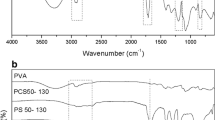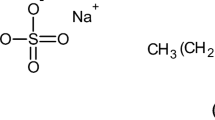Abstract
Hydrophobically associating polymer has been obtained by homogeneous copolymerization of acrylamide and an anionic surface-active monomers (surfmer) of acrylamide-type, sodium 2-acrylamido-tetradecane sulfonate (NaAMC14S) in aqueous solution, and under different concentration conditions of NaAMC14S above its critical micellar concentration (CMC) and below CMC, two structure types of copolymers P (AM–NaAMC14S) were prepared in which main chains NaAMC14S were distributed in microblock and in random manner, respectively. The hydrophobically associating property and rheological behaviour of the copolymers were studied with viscosimetry and then by fluorescence probe method. It was found that the apparent viscosity of the aqueous solution of the copolymers with microblock structures exhibits strong positive salinity sensitivity, whereas the positive salinity sensitivity of the apparent viscosity of the aqueous solution of the copolymers with random structure only appears generally and the apparent viscosity was diminutively increased because of salinity-promoting hydrophobic association. For those copolymers with microblock structures, the apparent viscosities of their brine solution are much higher than that of their pure water solution. In CaCl2 solution (2 wt%), as the copolymer concentration attains 0.2 wt%, the apparent viscosity enhances dramatically with the increase in concentrations, and as the copolymer concentration was 0.3 wt%, the apparent viscosity can enhance by almost two orders of magnitude (from 32 to 1,000 mPa·s) as compared with in pure water solution. Thus, for copolymer P (AM–NaAMC14S) with microblock structure, the peculiar positive salinity sensitivity, i.e. salinity thickening, is displayed distinctly. The unusual positive salinity sensitivity of copolymers P (AM–NaAMC14S) with microblock structure was also revealed by fluorescence probe method, and the value I 1/I 3 of pyrene in the brine solution of the copolymers was smaller than that in pure water solution of the copolymers. This unique salinity sensitivity is a reflection of the unusual microstructure of the copolymers. The experiment results are interpreted in terms of the effects of the surfmer distribution manner in the copolymer main chain and bonding way of the ionic surfmer to the copolymer main chain on the forming intermolecular association.









Similar content being viewed by others
References
Umar Y, Al-Muallem HA, Abu-Sharkh BF, Ali SA (2004) Polymer 45:3651–3661
Feng Y, Billon L, Grassl B et al (2005) Polymer 46:9283–9295
Volpert E, Selb J, Francoise C (1998) Polymer 39:1025–1033
Feng Y, Billon L, Grassl B et al (2005) Polymer 46:9283–9295
Xue W, Hamley IW, Castelletto V et al (2004) Eur Polym J 40:47–56
Shashkina YA, Zaroslov YD, Smirnov VA, Philippova OE et al (2003) Polymer 44:2289–2293
Taylor KC, Nasr-Ei-Din HA (1998) J Pet Sci Eng 19:265–280
Candau F, Selb J (1999) Adv Colloid Interface Sci 79:149–172
Taylor KC, Nasr-EI-DIN HA (1998) J Pet Sci Eng 19:265–280
Hill A, Candau F, Selb J (1993) Macromolecules 26:4521–4532
Ye L, Luo K, Huang R (2002) Eur Polym J 36:1711–1715
Wu H, Kawaguchi S, Ito K (2004) Colloid Polym Sci 282:1365–1373
Summers M, Eastoe J, Davis S, Du Z (2001) Langmuir 17:5388–5397
Herold M, Brunner H, Tovar GEM (2003) Macromol Chem Phys 204:770–778
Summers M, Eastoe J (2003) Adv Colloid Interface Sci 100–102:137–152
Hirai T, Watanable T, Komasawa I (2000) J Phys Chem B 104:8962–9866
Schoonbrood HAS, Unzué MJ, Asua JM et al (1997) Macromolecules 30:6024–6033
Guyot A (2004) Adv Colloid Interface Sci 108–109:3–22
Xu XJ, Chen FX (2004) Polymer 45:4801–4810
Stähler K, Shelb J, Candau F (1999) Mater Sci Eng C 10:171–178
Tuin G, Candau F, Zana R (1998) Colloids Surf 131:303–313
Yu Y-M, Wang Z-H, Gao B-J, Wang R-X (2005) Chinese Journal of Colloid and Polymer 23(4):26–31 (in Chinese)
Yu Y-M, Wang Z-H, Gao B-J, Wang R-X (2006) Acta Physico-Chemica Sinica 22(4):496–501 (in Chinese)
Winnik FM, Winnik MA, Tazuke S (1987) J Phys Chem 91:594–597
Gosselet N M, Beucler F, Renard E et al (1999) Colloids Surf A Physicochem Eng Asp 155:177–188
Blagodatskikh IV, Sutkevich MV, Sitnikova NL, Churochkina NA, Pryakhina TA, Philippova OE et al (2002) J Chromatogr A 976:155–164
Li Y, Kwark JCT (2002) Langmuir 18:10049–10051
Smith GL, McCormick CL (2001) Macromolecules 34:5579–5586
Morimoto H, Hashidzume A, Morishima Y (2003) Polymer 44:943–952
Acknowledgement
The authors are grateful to the Science Foundation of Province Shanxi of China for the financial support of this work.
Author information
Authors and Affiliations
Corresponding author
Rights and permissions
About this article
Cite this article
Gao, B., Jiang, L. & Kong, D. Studies on rheological behaviour of hydrophobically associating polyacrylamide with strong positive salinity sensitivity. Colloid Polym Sci 285, 839–846 (2007). https://doi.org/10.1007/s00396-006-1613-5
Received:
Accepted:
Published:
Issue Date:
DOI: https://doi.org/10.1007/s00396-006-1613-5




